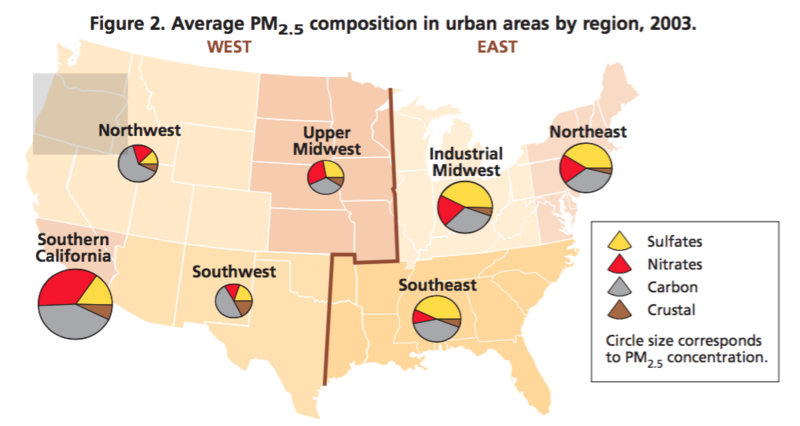image: EPA 454-R-04-002, Fig 2
What procedure is best to determine background airborne silica levels?
We are looking to deploy MiniVol filter-based PM samplers to determine the background particulate matter levels in air, particularly for silica emissions around frac sand mines.
A major community question has been, "what percentage of airborne PM is from the mines or dangerous crystalline silica?
While several Wisoconsin mines have PM monitors active, all are performing gravimetric analysis to determine total airborne PM and using EPA assumptions of 10% silica.
Both industry and community-collected PM measurements would benefit from a better understanding of the relative mixture of silica and other PM sources in background air quality.
Potential tests
24-hour samples with the MiniVol can be subjected to several different lab methods to determine silica content of PM. Three different lab methods are available for the Minivol that can look at silica content. These are the same cost regardless of whether PM2.5, PM10, or PM4 are measured:
| Analysis Method | Analysis target | cost | notes |
|---|---|---|---|
| Gravimetric analysis, NIOSH 0500 | Total mass of PM | $20-25 | essential first step before other tests |
| X-Ray Fluorescence (XRF) | total silicon | $30 | elemental silicon, not silica or crystalline silica specifically |
| X-Ray Spectroscopy (XRD) | Quartz only | $65 | |
| X-Ray Spectroscopy (XRD) | Quartz & Cristobalite | $75 | |
| X-Ray Spectroscopy (XRD) NIOSH 7500 | Cristobalite and Tridymite | $85 |
Sampling frequency/quantity?
How many 24-hour sampling periods are needed to say something meaningful about background silica levels?
This question can be divided into two questions, I believe.
- what meets Federal Reference Method requirements?
- what is statistically significant?

Hi Matthew, We met briefly years ago when you visited with Mike O'Connor in Buffalo County Wisconsin. Since then I've hopefully learned a bit more and helped out with analysis of a University of Iowa monitoring project in Trempleau county. I'm sure you are familiar with the Richard's study of silica at the EOG facility in Chippewa Falls and I would hope you are familiar with the U of Iowa study which included silica sampling around a few homes. Neither of these showed silica concentrations anywhere near the current suggested health guidelines. Yes, Richards was employed by the industry and one can see where his methods could have been improved, but there is no evidence of data manipulation. I bring these up in relation to your second question about "statistical significance". You haven't given any explanation of what this might mean to you. Often it's a statement of whether whatever is being measured is different from zero. To make an assessment of this and to suggest a sample size one needs an estimate of variability. If you do not use these past studies to give a reasonable estimate you have nothing to begin with and need to go out and monitor a lot! You need to do this anyway because outdoor ambient monitoring needs to consider all kinds of weather conditions. This is not a controlled environment. In addition if you want to try and assess what might be coming from a facility you need to be sure your baseline is NOT coming from the facility. Then the difference might be relevant to your question about the facility. I write "might" because there is still the work of trying to attribute the difference to the facility. The complexities of this type of analysis is something many people do not understand. These studies can not be done quickly. I suspect you know all this. In addition there is the question of whether work at a facility is consistent enough that a 24 hour average concentration will answer the community's questions. I've witnessed and photographed a mine blast and the corresponding dust cloud. One could see the dust cloud for less than 15 seconds before it had dispersed enough to no longer be identifiable. Concentrations of silica could have been very high within the cloud produced but the cloud was no where near where I was standing and even if it was, very high concentration for 15 seconds out of 24 hours would not have a discernible signal unless the concentration was truly enormous. 24 hour averaging is problematic by itself and in my opinion should always be used in association with pm monitoring of at most every minute. It is the case that concentrations of silica are usually so low that a monitoring period has to be of sufficient length that enough accumulates on a filter to be measurable. This makes getting answers to questions much more difficult but also pushes one to be creative. jeff falk
Reply to this comment...
Log in to comment